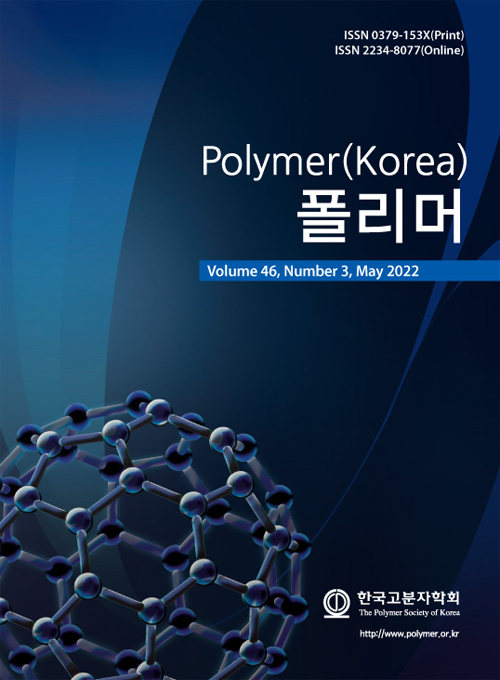- Cationic Ring-opening Polymerization of Cyclic Dithiocarbonates Enhanced by a Neighboring Sulfur Atom
Department of Chemistry Education, Pusan National University, 2, Busandaehak-ro, 63beon-gil, Geumjeong-gu, Busan 46241, Korea
- 고리형 디티오카보네이트의 양이온 개환 중합과 인접한 황에 의한 개환 유도 효과
부산대학교 화학교육과
Reproduction, stored in a retrieval system, or transmitted in any form of any part of this publication is permitted only by written permission from the Polymer Society of Korea.
Cationic ring-opening polymerization was investigated with three cyclic dithiocarbonates. Neighboring sulfide and ether groups stabilize a cationic intermediate appeared in the structural reorganization of cyclic monomers and suppress competitive isomerization, leading to a high polymer conversion. A heterocyclic substituent with sulfur and oxygen on a monomer changed to a smaller heterocycle in the corresponding polymer. A plausible mechanism for the ring contraction was proposed involving neighboring group participation. The polymerization exhibited the characteristics of living polymerization such as a narrow molecular weights distribution, which was controllable with initiator contents. The thermal stability of the prepared poly(dithiocarbonate) was enhanced by end-capping reaction.
3종의 고리형 디티오카보네이트 단분자를 사용하여 양이온 개환 중합반응을 진행하였다. 단분자로부터 생성된 개환반응 중간체의 안정화 효과를 통해 고분자 전환율을 증가시키고자 황과 산소가 도입된 단분자를 합성하였다. 황과 산소를 포함한 헤테로고리가 치환체로 도입된 경우, 고분자 반응과정에서 고리 크기가 감소하는 현상을 관찰하였다. 이를 설명하는 반응 메카니즘을 제안하고 인접기 효과를 확인하고자 한다. 양이온 중합반응 개시제로 사용된 MeOTf의 양을 조절하여 합성된 고분자의 분자량을 조절하고 좁은 분자량분포의 고분자 형성을 통해 리빙중합 특성을 확인하였다. 고분자 사슬의 말단 종결반응을 진행하여 생성된 고분자의 열안정성을 향상시킬 수 있었다.
Keywords: poly(dithiocarbonate), ring-opening polymerization, neighboring group participation, living polymerization.
- Polymer(Korea) 폴리머
- Frequency : Bimonthly(odd)
ISSN 0379-153X(Print)
ISSN 2234-8077(Online)
Abbr. Polym. Korea - 2023 Impact Factor : 0.4
- Indexed in SCIE
 This Article
This Article
-
2022; 46(3): 377-381
Published online May 25, 2022
- 10.7317/pk.2022.46.3.377
- Received on Jan 26, 2022
- Revised on Mar 10, 2022
- Accepted on Mar 17, 2022
 Correspondence to
Correspondence to
- Jung Yun Do
-
Department of Chemistry Education, Pusan National University, 2, Busandaehak-ro, 63beon-gil, Geumjeong-gu, Busan 46241, Korea
- E-mail: jydo@pusan.ac.kr










 Copyright(c) The Polymer Society of Korea. All right reserved.
Copyright(c) The Polymer Society of Korea. All right reserved.